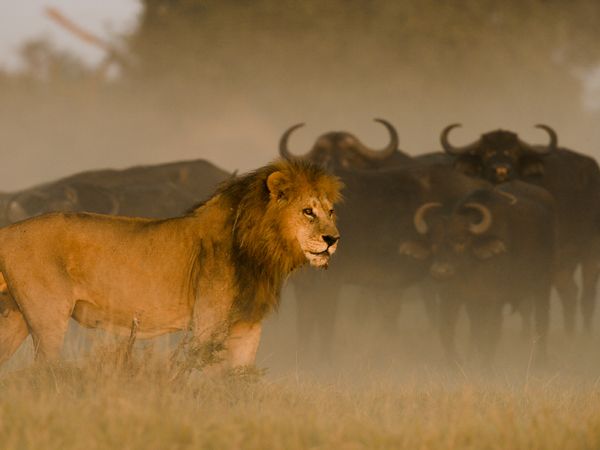
Against a constant backdrop of African buffalo, the lions of Duba are highlights on a dark canvas. (BEVERLY JOUBERT/ National Geographic)
Hollywood has consistently reverted to the animal kingdom for sources of its most dramatic features. With daring territory battles, intense fights for survival, and captivating story lines, who wouldn’t?
National Geographic’s latest film, featuring the works of veteran filmmakers Beverly and Derrick Joubert, “The Last Lions,” follows an exiled mother as she fights to keep her three children alive after losing her mate and being forced out of her homeland by a rival pride.
Photographing lions for almost 30 years, the Joubert’s visuals are nothing short but stunning. With vast shots encompassing the wild animal kingdom, intimate portraits of certain animals and fascinating footage highlighting nature’s most incredible story, “The Last Lions” could completely dismiss Jeremy Iron’s narration and still be a captivating film.
The documentary’s main focus lies on Ma di Tau (Mother of Lions), as she battles the harshness that is the wilderness in hopes of saving her children’s lives. Problems arise when Ma di Tau is forcibly made to move to new lands. Standing in the way of her and survival lays hungry crocodiles, scheming lions, and greedy hyenas
Perhaps “The Last Lion’s” biggest flaw, however, comes from its celebrity narrator, Jeremy Irons. Iron’s voice is iconic; there is no doubt in that fact. However, at times during the movie, the lines he is delivering are somewhat exaggerated and occasionally too much to swallow.
Despite its misstep in narration, “The Last Lions” is still one of the best nature documentaries to be released in the past decade. What makes “The Last Lions” so enthralling to watch is the emotional connections that the Joubert’s cinematography forces upon you. Midway through the 88-minute feature, you find yourself forgetting that Ma di Tau and her cubs are merely lions. Instead, the fabled felines undergo a metamorphosis into human-like creatures who you can do nothing but root for their survival.
Even though “The Last Lions” is labeled as PG, the sometimes graphic images may not exactly be for children, at least not those under the age of 10. At points during “The Last Lions,” the utter reality of the Joubert’s photography is more graphic than even the worst of today’s action movies. While the intense visuals are necessary to forward the story, some children may be eclipsed by their shear honesty.
The Jouberts, who are an integral part of National Geographic’s “Big Cat Initiative,” made “The Last Lions” to highlight the sever changes that lions are undergoing due to poaching and the loss of their habitat.
“The Last Lions” is a captivating film from beginning to the end. The film invites its audiences to get lost in the tundra of the African wild and successfully does so by combining stunning cinematography and a stellar story line.
The film is showing at the Angelika Dallas this Friday.










